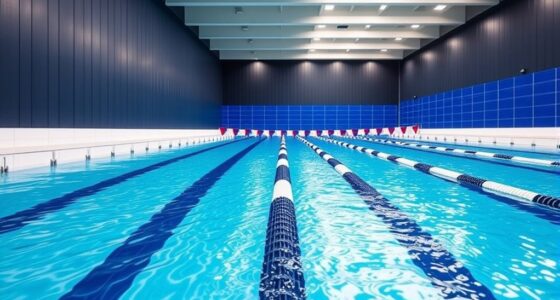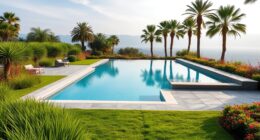If you’re weighing an endless pool versus a lap pool, consider space, cost, and versatility. Endless pools are compact, easy to install, and blend seamlessly into indoor or outdoor spaces, making them cost-effective with lower maintenance. Lap pools are larger, ideal for extensive exercise, but involve more construction and higher ongoing costs. Each offers unique benefits, so exploring further will help you decide which suits your lifestyle and long-term goals best.
Key Takeaways
- Endless pools are space-saving, ideal for indoor or small outdoor areas, while lap pools typically require larger, dedicated outdoor space.
- Endless pools generally cost less upfront and have lower ongoing maintenance and energy expenses than traditional lap pools.
- Endless pools offer adjustable currents for versatile workouts, whereas lap pools are primarily designed for swimming laps.
- Lap pools may increase property value with their traditional appeal but involve more extensive installation and higher long-term costs.
- Endless pools blend seamlessly into modern decor and can be discreetly integrated, enhancing aesthetic appeal and resale potential.
Design and Space Considerations

When choosing between an endless pool and a traditional lap pool, considering the design and space requirements is essential. Endless pools are compact and versatile, fitting into small yards, basements, or even garages. Their size allows for placement in tight spaces without sacrificing functionality. In contrast, lap pools are longer and require more room, often occupying a significant portion of your yard or outdoor area. If space is limited, an endless pool offers a sleek, integrated design that blends seamlessly with your environment. Additionally, the space efficiency of endless pools makes them an appealing choice for those with restricted outdoor or indoor areas. However, if you have ample space and prefer a traditional swimming experience, a lap pool provides a longer, open swimming lane. Your choice depends on your available space and how you envision integrating the pool into your property’s design.
Cost and Installation Factors

When choosing between an endless pool and a lap pool, you’ll want to think about the initial costs, installation process, and ongoing maintenance expenses. Endless pools typically have a lower purchase price but might require simpler setup, while lap pools can be more expensive and complex to install. Keep in mind that long-term upkeep can also impact your overall budget, so it’s important to weigh these factors carefully. Additionally, considering nutritional benefits of water-based exercise can help you decide which option aligns better with your health goals.
Initial Purchase Expenses
The initial purchase cost of an endless pool typically falls between $15,000 and $25,000, while a traditional lap pool can vary widely depending on size and features. Endless pools are compact, designed for installation in smaller spaces, which helps keep costs lower upfront. You mainly pay for the integrated tank, swim current system, and basic accessories. In contrast, lap pools often require larger excavation, custom construction, and more extensive materials, increasing initial expenses. Additional features like heating, lighting, or decking can considerably raise costs for either option. While endless pools offer a more affordable and space-efficient solution, traditional lap pools may require a bigger investment upfront, especially if you opt for high-end finishes and custom designs. Additionally, the technological features integrated into endless pools can enhance their functionality and user experience, making them a popular choice for many homeowners.
Installation Complexity
Installing an endless pool is generally straightforward because it’s designed for easy setup in smaller spaces, often fitting into existing rooms or patios. You typically don’t need extensive construction, making installation quicker and less costly. In contrast, lap pools usually require more complex installation, including excavation, significant plumbing, and possibly structural modifications. Here’s a quick comparison:
| Aspect | Endless Pool | Lap Pool |
|---|---|---|
| Space Requirements | Fits indoors or small patios | Larger area needed |
| Construction Needs | Minimal, simple setup | Extensive, structural work |
| Time to Install | Shorter, usually days | Longer, sometimes weeks |
This difference impacts your initial setup cost and effort, with endless pools being more convenient to install. Additionally, installation complexity can influence long-term maintenance and accessibility.
Long-term Maintenance Costs
Although endless pools typically have lower initial installation costs due to their simpler setup, their long-term maintenance expenses can vary considerably from lap pools. Endless pools often require less water and fewer chemicals, which can reduce ongoing costs. However, their compact size means that equipment like pumps and filters may need more frequent servicing, and parts can be pricier to replace. Lap pools tend to have larger water volumes, increasing chemical use and filtration costs over time. Additionally, lap pools may require more energy to heat and operate, raising utility bills. Overall, while endless pools might save you money upfront, you should consider ongoing expenses like chemical balancing, equipment upkeep, energy consumption, and water efficiency when comparing long-term costs.
Maintenance and Operating Expenses

Are you wondering how maintenance costs compare between an endless pool and a traditional lap pool? Generally, endless pools have lower ongoing expenses due to their compact size and integrated systems. They require less water and chemicals, reducing chemical costs and filtration time. In contrast, lap pools, especially larger ones, need more chemicals, regular cleaning, and water refilling, raising expenses over time. Additionally, the total-cost clarity of each option can influence long-term budgeting and decision-making.
Exercise Versatility and Functionality

When it comes to exercise options, an endless pool offers impressive versatility that can adapt to your fitness needs more readily than a traditional lap pool. Its adjustable current allows you to customize resistance levels, making it suitable for everything from gentle water walking to intense sprint training. You can switch between swimming laps, aqua aerobics, or even resistance exercises targeting different muscle groups. The compact design means you’re not limited by space, enabling you to perform various workouts in a smaller area. Unlike lap pools, which mainly focus on swimming laps, endless pools support diverse routines, including low-impact rehab exercises and high-intensity interval training. This adaptability makes an endless pool a highly functional tool for improving overall fitness and accommodating multiple workout styles. Additionally, some models incorporate features like hydrotherapy technology, enhancing recovery and relaxation after workouts.
Aesthetic Appeal and Integration

A well-designed endless pool seamlessly blends into your outdoor or indoor space, enhancing the overall aesthetic rather than detracting from it. Its compact size and sleek design allow it to fit comfortably without overwhelming your environment. You can customize the appearance with various finishes, colors, and decking options, making it a stylish addition rather than an eyesore. Unlike traditional lap pools, which often require extensive space and can dominate a yard or gym, endless pools offer a modern, minimalist look that complements your existing decor. They can be integrated discreetly into patios, basements, or backyard landscapes, providing a luxurious feel without sacrificing visual harmony. Additionally, the aesthetic appeal of an endless pool can significantly increase the perceived value of your property. Overall, an endless pool enhances your space’s visual appeal while maintaining a seamless, cohesive look.
Long-term Investment and Value

When considering your long-term investment, think about how each pool type holds up over time and the costs involved. Endless pools often save you money on maintenance, but lap pools may have better resale value. Your choice impacts not just your enjoyment now but also the overall value you get later.
Cost Over Time
While both endless pools and lap pools require an upfront investment, their long-term costs can vary greatly. Endless pools typically have lower ongoing expenses because they use less water and energy, thanks to their smaller size and efficient circulation systems. Maintenance costs are usually minimal, with fewer chemicals needed and less filtration required. Lap pools, on the other hand, tend to be more expensive over time due to their larger size, higher water consumption, and increased energy use for heating and filtration. Additionally, cleaning and chemical costs are higher for traditional pools. If you’re focused on minimizing long-term expenses, an endless pool offers a more cost-effective solution. Moreover, the water efficiency of endless pools can lead to significant savings on utility bills over time. However, your choice should also consider how often you’ll use the pool and your specific maintenance preferences.
Resale Potential
Because long-term costs can influence your overall investment, considering how each pool type holds its value over time is important. An endless pool tends to have a higher resale value due to its compact design and popularity among homeowners seeking convenience and modern features. Its versatility makes it appealing to a broad market, especially for those looking for a space-efficient fitness option. In contrast, lap pools often have a more niche appeal; their resale value depends heavily on location and home size. If you live in an area where outdoor pools are common, a lap pool might retain value better. Ultimately, an endless pool’s modernity and space-saving design generally make it a more attractive long-term investment. Additionally, the resale potential of each pool can be influenced by emerging trends in community engagement and lifestyle preferences.
Frequently Asked Questions
Which Pool Type Is Better for Small Backyard Spaces?
If you have a small backyard, an Endless Pool is a better choice because it’s compact and fits into tight spaces. You can install it indoors or outdoors, making it versatile. It offers resistance swimming and fun features without taking up too much room. A lap pool might be too large and difficult to fit, but an Endless Pool maximizes your space while providing a great swimming experience.
How Do Water Temperature Controls Differ Between the Two Pools?
While both pools offer temperature control, they differ markedly. Endless pools often feature integrated, user-friendly digital thermostats, allowing you to easily set and adjust the water temperature. In contrast, lap pools may rely on external systems or manual adjustments, which can be less precise. You’ll find the endless pool offers quicker, more consistent control, making it ideal for frequent changes or precise comfort, unlike the more traditional setup of lap pools.
Can Both Pools Be Used Year-Round Indoors?
Yes, you can use both pools indoors year-round. Indoor settings protect them from weather, allowing continuous use regardless of season. With proper heating, you’ll enjoy comfortable water temperatures at any time. Just guarantee your space has good ventilation and humidity control to prevent mold or damage. Both pools are designed for indoor installation, so with the right setup, you can swim whenever you want, all year long.
Are There Specific Safety Features Unique to Each Pool Type?
You might think safety features are similar across pool types, but each has unique aspects. Endless pools often include built-in safety covers, slip-resistant decks, and touch-sensitive emergency shut-offs, while lap pools typically feature sturdy handrails, anti-slip flooring, and robust perimeter fencing. These differences stem from their designs and usage, so you should evaluate which features best suit your safety needs and space, ensuring a secure swimming experience year-round.
How Quickly Can Each Pool Be Installed and Ready for Use?
You can typically have an Endless Pool installed within a few days, especially if it’s a pre-made model that’s easy to set up. Lap pools, especially in-ground ones, take longer—sometimes several weeks—due to excavation, construction, and finishing work. Above-ground lap pools are quicker, often ready within a week. Your timeline depends on the pool type, installation complexity, and whether you’re doing DIY or hiring professionals.
Conclusion
Think of choosing between an endless pool and a lap pool as selecting a trusted companion on your fitness journey. An endless pool is like a loyal guide, offering versatility and convenience, while a lap pool is a dedicated athlete, perfect for serious swimmers. Whichever path you choose, it becomes a part of your daily routine—transforming your backyard into a personal oasis. Your decision shapes your wellness adventure, turning your space into a sanctuary of health and relaxation.









